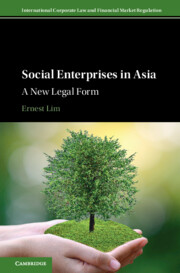Book contents
- Social Enterprises in Asia
- Reviews
- International Corporate Law and Financial Market Regulation
- Social Enterprises in Asia
- Copyright page
- Contents
- Tables
- Acknowledgements
- Table of Cases
- Table of Legislation and Regulations
- Abbreviations
- 1 Introduction and Overview
- 2 Corporate Purpose
- 3 Directors’ Duties
- 4 Decision-Making Powers
- 5 Reporting, Impact Measurement, and Certification
- 6 Distribution of Dividends, Assets, and Tax Benefits
- 7 Conclusion
- Appendix 1 List of 80 Social Enterprises
- Bibliography
- Index
1 - Introduction and Overview
Published online by Cambridge University Press: 12 March 2023
- Social Enterprises in Asia
- Reviews
- International Corporate Law and Financial Market Regulation
- Social Enterprises in Asia
- Copyright page
- Contents
- Tables
- Acknowledgements
- Table of Cases
- Table of Legislation and Regulations
- Abbreviations
- 1 Introduction and Overview
- 2 Corporate Purpose
- 3 Directors’ Duties
- 4 Decision-Making Powers
- 5 Reporting, Impact Measurement, and Certification
- 6 Distribution of Dividends, Assets, and Tax Benefits
- 7 Conclusion
- Appendix 1 List of 80 Social Enterprises
- Bibliography
- Index
Summary
This chapter articulates the central argument (why a new legal form for social enterprises in India, Malaysia, Hong Kong, and Singapore is needed and what it should entail); explains why the four Asian jurisdictions are selected as case studies; and examines the purposes of social enterprises and their two main business models. The chapter then provides an overview of social enterprises in the four Asian jurisdictions including: their operating domains, the drivers of the development of social enterprises, the challenges faced by them, the three main conflicts of interests afflicting them, and the legal forms used by social enterprises. Importantly, the chapter shows that the legal forms available to or used by social enterprises in the four Asian jurisdictions are unable to properly address the conflicts of interests, and thus, a new legal form is required.
Keywords
- Type
- Chapter
- Information
- Social Enterprises in AsiaA New Legal Form, pp. 1 - 45Publisher: Cambridge University PressPrint publication year: 2023



